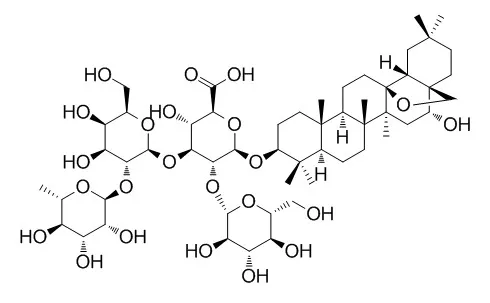| In vitro: |
| European Journal of Microbiology & Immunology, 2014, 4(4):204-212. | | Saponins increase susceptibility of vancomycin-resistant enterococci to antibiotic compounds.[Reference: WebLink] | The resistance of commensal bacteria to first and second line antibiotics has reached an alarming level in many parts of the world and endangers the effective treatment of infectious diseases.
METHODS AND RESULTS:
In this study, the influence of the plant-derived natural saponins glycyrrhizic acid, β-aescin, α-hederin, hederacoside C, and primulic acid 1(Primulic acid I) on the susceptibility of vancomycin-resistant enterococci (VRE) against antibiotics of clinical relevance was investigated in 20 clinical isolates. Furthermore, the antibacterial properties of saponins under study against VRE were determined in vitro. Results reveal that the susceptibility of VRE against gentamicin, teicoplanin, and daptomycin was enhanced in the presence of the saponin glycyrrhizic acid. Most importantly, glycyrrhizic acid (1 mg/ml) diminished the minimal inhibitory concentration (MIC) of gentamicin in gentamicin low-level intrinsic resistant VRE from 2 - >8 mg/l to ≤ 0.125-1 mg/l. The adding of β-aescin, α-hederin, hederacoside C, and primulic acid 1 to the antibiotics under study showed, compared to glycyrrhizic acid, less influence on the antibiotic potency. Only glycyrrhizic acid (1 mg/ml) and α‑hederin (0.2 mg/ml) showed weak antibacterial properties against the clinical isolates.
CONCLUSIONS:
Our study points towards a therapeutic potential of saponins in the coapplication with antibiotics for bacterial infections. |
|






 Cell. 2018 Jan 11;172(1-2):249-261.e12. doi: 10.1016/j.cell.2017.12.019.IF=36.216(2019)
Cell. 2018 Jan 11;172(1-2):249-261.e12. doi: 10.1016/j.cell.2017.12.019.IF=36.216(2019) Cell Metab. 2020 Mar 3;31(3):534-548.e5. doi: 10.1016/j.cmet.2020.01.002.IF=22.415(2019)
Cell Metab. 2020 Mar 3;31(3):534-548.e5. doi: 10.1016/j.cmet.2020.01.002.IF=22.415(2019) Mol Cell. 2017 Nov 16;68(4):673-685.e6. doi: 10.1016/j.molcel.2017.10.022.IF=14.548(2019)
Mol Cell. 2017 Nov 16;68(4):673-685.e6. doi: 10.1016/j.molcel.2017.10.022.IF=14.548(2019)